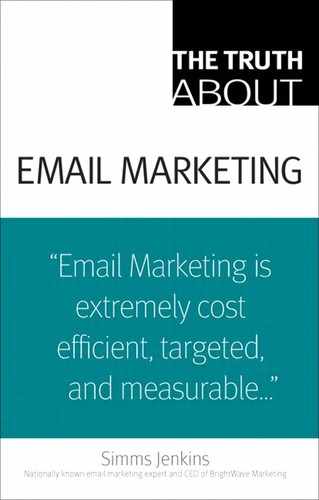Truth 30. Use your signature line
To me, email marketing success has always been about the little things—a well thought-out footer, a perfectly placed contextual cross promotion, or a convincing Subject line that has been tested and proven to be battle ready. So it may come as no surprise that I have always spent a good deal of time ensuring my personal email signature was just right, while also analyzing the email signatures of others that flowed into my inbox.
Email signatures are placed below the content of any personal email and are readily available for creation and use in almost all email clients. Originally, their primary use was for providing basic contact information, but like email marketing, they have slowly morphed into a more sophisticated one-to-one marketing message. Email signatures vary wildly from person to person, company to company, and often by position. However, often, we miss some great branding and direct-response opportunities in our business email signatures.
Let's look at how to elevate your email signature into a value-added marketing message that can be seen by everyone you email with directly (not to be mistaken with company email campaigns).
Contact information
While this is the most prevalent item included in business email signatures, it should include basics on how the recipient can contact you in the future, your title/role in the organization, and your website URL. While the email address of the sender can be found in the From line, many people want to add you immediately to their contacts, so make it easy for them to export or cut and paste all contact info into Outlook. This is of particular importance for those in sales. What good is an email dialogue where a subtle or overt sales pitch is the focus but follow-up contact information is hard to find or not included?
Consistency
It is surprising to receive emails from different individuals from the same company with different colors, company information, and overall styling. While it is difficult and maybe draconian to enforce companywide (at least in large organizations) standards on something considered personal like email signatures, it is wise to encourage consistency. After all, you don't want disparate marketing messages to be seen every time someone in your company communicates with a potential customer.
Fonts and background colors may seem trivial in email signatures, but they do reflect your company's image in email communications. Plus, some images, signature fonts, and colors can be blocked and render horribly in the inbox and make a strong impression—just not the kind you are seeking.
Company overview/branding position/tag line
I am continually amazed whenever I receive emails from high-level employees at world-renowned brands and their email signatures fail to include a single thing about their company. While this may reflect personal or company modesty, I find it to be a missed opportunity given the amount of money big brands spend on creating awareness. A brief company overview (think elevator pitch—one wants to avoid warlording, which has been coined for bloated signatures) with a tag line or brand value proposition should be essential to any business email signature.
Marketing focus/awards
On a rotating basis, savvy marketers change cross promotions and timely advertising messages in their offline, email, and search campaigns. Why not implement this in your signature as well? If a company or product has received a recent award or currently has a major promotion, a simple description link can be both appropriate and relevant. This can also indirectly engage recipients in viral behavior.
Newsletters/blogs/events
Almost without exception, companies today offer email newsletters and, to a lesser degree, blogs. Include links to these relationship-building tools. However, it's best not to promote a noncompany blog in your business signature unless it is industry-focused.
One of our clients does an exceptional job of including upcoming events in individuals’ signature lines. If your primary revenue depends on such an event, it is a best practice to include these in all your customer touch points.
Compliance
According to WebSurveyor, which polled 1,082 organizations, almost 84 percent said they received no training or information from their organization about the U.S. CAN-SPAM Act1 (see Truth 39). From personal experience, I've found that almost 99 percent of personal email solicitations fail to include any type of reference to providing an opt-out.
This law is not solely the grounds of broad email “campaigns,” but also of sales individuals sending out one-to-one emails that are essentially email's version of cold calls. Anyone who uses email to seek new business should include a basic reference in or below the email signature on how to opt out of future emails from that company. The implementation of removing individuals one by one from its sales force is not an easy thing but something that should be closely evaluated by almost every company with a sales force.
Whether you are an account coordinator, VP of sales, or a customer care representative, it would be wise to rethink the way you interact with all recipients in your day-to-day emails. Your email signature is a perfect place to start.
